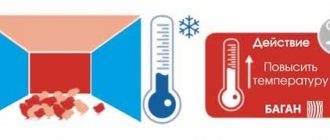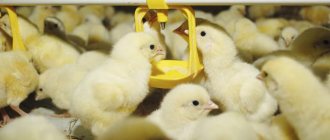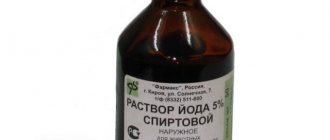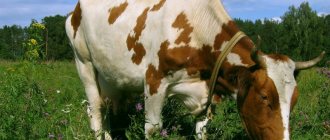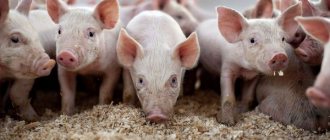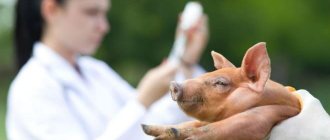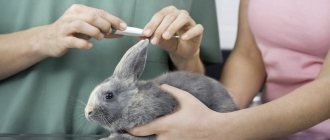Pharmacological qualities
Rhodotium 45% is an antibacterial veterinary drug, the therapeutic effect of which depends on the activity of the main substance - tiamulin, an antibiotic of the pleuromutilin group, which is active against:
- certain types of mycoplasmas;
- brachyspira;
- bacteria.
Rhodotium 45%:
- stops the synthesis of proteins by microbes;
- creates inactive biochemical complexes;
- prevents the growth of the polypeptide chain.
After consumption, the medicine is absorbed by the gastrointestinal tract, enters the organs and tissues of poultry and animals, peaking within 2-4 hours. Maintained in therapeutic concentration from 18 hours to 24 hours. Excreted in bile. According to the degree of influence on the body, it belongs to class 4 (low-hazard drug).
Analogs
Other pharmaceutical companies also produce drugs similar to Rodotium. They all use tiamulin as the active ingredient.
| Name | Manufacturer | Type of packaging | Shelf life in original packaging after first opening |
| "Tialong" 45% | NITA-FARM, Russia | Glass bottles with a capacity of 1 kg | 4 months |
| "Tiam-45" | "BioTestLab", Ukraine | Powder | 1 month |
| "Tiamulin" 45% VK | Ultravet, Russia | 100 gram foil packet, powder | 1.5 months |
Since all medications have the same concentration of the active substance, their dosages coincide with the consumption rates of Rodotium.
Indications for use
Rhodotium 45% is prescribed to poultry and pigs for the prevention and treatment of:
- mycoplasma infections of poultry due to Mycoplasma meleagridis, synovia and gallisepticum;
- pneumonia, mycoplasma arthritis, spirochetosis, dysentery and porcine enterocolitis.
Mycoplasmosis
Symptoms of the acute form: shortness of breath, sneezing, wheezing in the trachea, redness of the eyes and foamy discharge from them, decreased appetite and egg production
Read
What is the drug
Rhodotium has the main active ingredient in its composition - tiamulin at a dose of 45 g per 100 g, as well as excipients. Externally, it is light granules that have a peculiar odor and dissolve well in water. The antibiotic Rodotium is absorbed by the intestines of birds, and already in the first 24 hours it begins to suppress the multiplication of the virus in the body. Sufficient concentration for pigeons is achieved already 4 hours after they drink the solution.
The drug in bulk form has 3 types of packaging: 100 g, 1 kg and 10 kg. There is also a 10% tiamulin solution for injection. This antibiotic is most often used for the prevention and treatment of pigeons; it is given along with water. Rhodotium 45 is also suitable for treating chickens, chickens and many other domestic animals.
Instructions for use for poultry
Poultry for use of the drug:
- broiler chicks;
- parent stock of chickens;
- replacement chickens up to 16 weeks;
- turkeys
Expert opinion
Sadchikov Nikolay Alekseevich
Veterinarian ornithologist
Ask a Question
The drug in the form of granules is used individually or for a group of birds, dissolved in water for drinking. A new solution is diluted daily, which is the only source of drinking during the period of treatment and prophylactic measures.
Mycoplasma infections
In accordance with the official instructions of the manufacturer, the therapeutic and prophylactic dose of Rodotium 45% for parent stock, replacement chickens and broiler chicks is 0.067-0.11 g/kg of weight, for turkeys - 0.056-0.11 g/kg. The daily dosage for poultry is provided by drinking a 0.025% tiamulin solution for 3 to 5 days. To prepare a therapeutic and prophylactic dilution, the drug in the form of granules is dissolved in drinking water.
Dosage and use for chickens and turkeys for medicinal purposes
Algorithm for use:
- Add 5 g of Rhodotium 45% granules to 10 liters of drinking water.
- This is a medicinal solution for feeding 38 broiler chickens, 66 young chickens aged 1-9 weeks and 43 heads from 10 to 16 weeks, as well as 37 units of parent stock and 34 turkeys from 1 to 9 weeks per day.
- Use 3 to 5 days every day.
Dosage and method of use for chickens and turkeys for the prevention of mycoplasmosis
Scheme:
- Dilute 5 g of Rhodotium 45% granules in 10 liters of drinking water . Apply 3 days to birds 1-3 days old. This volume is enough for a day for 42 broiler chickens, 66 replacement chickens and 33 turkeys.
- For broilers 4 weeks of age, add 2.5 g of the drug to 10 liters of water . Apply consecutively for 2-3 days. This is the daily requirement for feeding 42 broilers.
- In the presence of pathological changes in replacement chickens and turkeys, a therapeutic dilution is prepared from a ratio of 5 g of the product per 10 liters of water . This is the volume for feeding 66 young chickens and 33 turkeys per day. Preventive course - 3 days in a row every month.
Did the antibiotic Rodotium 45% help you treat mycoplasma infections in birds?
HelpedNo
Dosage of Rhodotium
Pigeons should be given Rodotium only after consultation with a veterinarian, who will prescribe the required dosage depending on the condition of the birds. In addition to direct treatment, the veterinarian may prescribe the use of Rodotium as a disease prevention.
The recommendations for the drug provide general information about dosages and concentrations.
The required amount of the drug depends on the weight of the bird and its general condition.
The dosage must be calculated taking into account the weight, size and health status of the bird.
To ensure a daily dose of antibiotic, you need to give the bird a 0.025% solution for no more than 5 days in a row. This dose consists of a consumption rate of 0.067 – 0.11 g of “Rodotium” per 1 kg of weight. This supplies the body with 50 mg of tiamulin.
The correct solution is prepared from 1.1 g of the drug and 2 liters of clean water.
Dosage and application regimens for pigs
The drug is used in a group method or individually with drinking water. Fresh dilution is prepared daily based on daily water consumption. During therapy, other sources of water are prohibited.
Treatment regimens:
- Dysentery, enterocolitis of spirochetal origin . The daily dose of the drug is 0.02 g per kilogram of pig weight. Use for 3-5 days.
- Enzootic pneumonia, mycoplasma arthritis : 0.033-0.045 g/kg body weight per day. Course - 5-10 days.
- Pleuropneumonia : 0.045 g of the drug per kilogram of animal weight per day. Use from 5 to 7 days.
TIAM-45
Compound
1 g of the drug contains the active ingredient:
tiamulin hydrogen fumarate – 450 mg.
Excipients
Pharmacological properties
Tiamulin is a semisynthetic antibiotic belonging to the pleuromutilin group. The drug is active against gram-positive and gram-negative microorganisms (Brachyspira innocens, Brachyspira pilosicoli, Leptospira spp., Clostridium perfringens, Streptococcus spp., Staphylococcus spp., Erysipelothrix rhusiopathiae, Listeria monocytogenes, Pasteurella multocida, Actinomyces pyogenes, Actinobacillus spp., Fuso bacterium spp., Klebsiella pneumoniae, Haemophilus spp., Bacteroides spp., Campylobacter coli, Lawsonia intracellularis), as well as chlamydia and mycoplasmas (Mycoplasma hyopneumoniae, Mycoplasma hyosynoviae, M. hyorhinis, M. bovis, etc.).
Tiamulin acts at the 70S ribosomal level, the primary binding site is at the 50S sublevel, and the secondary site may be at the junction of the 50S and 30S sublevels. It inhibits the synthesis of proteins by microbes, creating biochemical inactive initiative complexes that prevent the growth of the polypeptide chain.
In the body of animals and poultry, the drug remains in antibacterial concentrations for 18-24 hours. Tiamulin reaches its maximum concentration in the body of poultry after 2 hours, and in the body of pigs – after 4 hours after oral administration. It is excreted from the body mainly in feces.
Target animals
poultry, pigs,
indications for use
Treatment of pigs with dysentery, as well as diseases of the respiratory system and joints caused by microorganisms sensitive to tiamulin.
Poultry (broilers, young poultry, laying hens, turkeys and poults): treatment of poultry for respiratory diseases caused by microorganisms sensitive to tiamulin.
Method of administration and dose
Orally with drinking water or food.
Pigs - for the treatment of dysentery, the dose is 0.02 g of the drug (8.8 mg of tiamulin) per 1 kg of animal body weight per day for 3-5 days, depending on the severity and duration of the infectious disease. The dose is provided at a tiamulin concentration in drinking water of 0.006%;
in the treatment of pigs with respiratory diseases caused by M. hyopneumoniae, P. multocida, the dose is 0.033-0.044 g of the drug (15.0-20.0 mg tiamulin) per 1 kg of animal body weight per day for 5-10 days. The dose is provided at a concentration of tiamulin in drinking water of 0.012% -0.018%;
for the treatment of pleuropneumonia caused by A.pleuropneumoniae, the dose is 0.044 g of the drug (20.0 mg tiamulin) per 1 kg of animal body weight per day for 5-7 days. The dose is provided at a tiamulin concentration in drinking water of 0.018%;
for the treatment of pigs with mycoplasma arthritis caused by Mycoplasma hyosynoviae, the dose is 0.044 g of the drug (20.0 mg tiamulin) per 1 kg of animal body weight per day for 5-7 days. The dose is provided at a tiamulin concentration in drinking water of 0.018%.
To prepare working solutions of the required concentrations of tiamulin, it is necessary to dissolve the drug TIAM 45 in drinking water according to the calculations given in Table 1.
Table 1.
| Concentration of tiamulin in drinking water, % | Amount of water per 100 g of TIAM 45, l | Amount of drug TIAM 45 per 100 l of drinking water, g |
| 0,006 | 750 | 13,3 |
| 0,012 | 375 | 26,7 |
| 0,018 | 250 | 40,0 |
| 0,025 | 180 | 55,6 |
To prepare a large volume of the drug solution, first prepare a concentrated solution (with a maximum concentration of 50-60 g of the drug per 1 liter of drinking water), and then dilute it to the required concentration. Fresh tiamulin solutions should be prepared daily.
Chickens (broilers, young poultry, laying hens and breeding birds) – for the treatment of poultry respiratory mycoplasmosis (RPM) and alveolar sacculitis caused by M. gallisepticum and M. synoviae, orally at a concentration of 0.025% tiamulin in drinking water for 3-5 days.
Depending on the age of the bird, the daily dose of tiamulin at a concentration of 0.025% in drinking water is:
day old chickens – 0.28-0.33 g of the drug (125-150 mg of tiamulin) per kg of body weight;
broilers under 4 weeks of age – 0.07-0.11 g of the drug (30-50 tiamulin) per kg of body weight;
chickens under 10 weeks of age - 0.07-0.10 g of the drug (30-45 tiamulin) per kg of body weight;
laying hens – 0.055 g of the drug (25 mg of tiamulin) per kg of body weight.
Table 2 below shows the drinking water requirements of poultry.
Table 2.
| Bird age, weeks | Amount of drinking water per day per 1000 heads, l | Dose of the drug to ensure a concentration of 0.025%, g |
| 4 | 60 | 33,3 |
| 6 | 80 | 44,4 |
| 8 | 100 | 55,6 |
| 10 | 120 | 66,7 |
| 12 | 140 | 77,8 |
| 14 | 160 | 88,9 |
| 16 | 180 | 100 |
| 18 | 200 | 111,1 |
| 20 | 220 | 122,2 |
| 23 | 250 | 138,9 |
Turkeys - for the treatment of infectious sinusitis and alveolar sacculitis caused by M. gallisepticum, M. synoviae and M. meleagridis orally with drinking water at a concentration of 0.025% tiamulin in drinking water for 3-5 days.
Depending on the age of the bird, the daily dose of tiamulin at a concentration of 0.025% in drinking water is:
1-week-old bird – 0.16 g of the drug (70 mg tiamulin) per kg of body weight;
2-4 week old poultry – 0.11 g of the drug (50 mg tiamulin) per kg of body weight;
5-8 week old poultry – 0.055-0.07 g of the drug (25-30 mg tiamulin) per kg body weight;
9-20 week old poultry – 0.044 g of the drug (20 mg tiamulin) per kg body weight.
Withdrawal period:
The slaughter of animals and poultry for meat is permitted respectively 4 days (pigs), 2 days (broilers, young poultry, laying hens and breeding poultry) and 5 days (turkeys) after the last use of the drug. Meat received before the specified period is disposed of or fed to non-productive animals, depending on the conclusion of the veterinary doctor. There is no withdrawal period for eggs.
Best before date
3 years.
Shelf life after first opening (selection): 28 days, provided it is stored in the manufacturer’s original packaging in a dry, dark place, out of reach of children, at a temperature of 5° to 25°C.
Shelf life after dilution in drinking water is 24 hours.
Storage conditions
Store in the manufacturer's original packaging in a dark place, out of reach of children, at a temperature of 5°C to 25°C.
Contraindications
The drug is prohibited for use:
- with individual intolerance to tiamulin;
- laying hens;
- replacement young animals over 16 weeks old;
- pregnant sows in the first 4 weeks of pregnancy;
- animals with functional disorders of the liver and kidneys;
- simultaneously with ionophore coccidiostats, aminoglycosides, and also within 1 week before taking the mentioned drugs and 1 week after taking them.
Drug for the treatment of colibacillosis in chickens
Furacilin
Drug for the treatment of infectious diseases in birds
Enromag
Antibiotic for the treatment of bacterial and mycoplasma infections in birds
Coliquinol
Antibacterial and antimycotic drug
Tiamulin
special instructions
Slaughter for meat in accordance with the instructions in the instructions for use is permitted the following number of days after consuming the drug:
- chickens — 3;
- turkeys — 4;
- pigs — 7.
Personal prevention:
- when working with Rodotium 45%, use protective equipment (goggles, gloves, respirator) and special clothing;
- it is forbidden to eat, drink, smoke;
- after performing the manipulations, wash your hands, face, rinse your mouth;
- Do not use empty medicine containers for household needs and dispose of them.
Side effects
Using Rodotium 45% in accordance with the manufacturer's recommended dosage does not cause adverse reactions. In pigs, erythema is occasionally possible, which stops after discontinuation of the drug.
First aid kit for broilers: chickens and adult birds. Mandatory groups of drugs
Read
Basic broad-spectrum antibiotics
More details
Enrostin for chickens - quick relief from salmonellosis, mycoplasmosis
Look
Baytril for chickens in the treatment of infectious diseases of the gastrointestinal tract and respiratory system
Further
Tetracycline is an effective and inexpensive drug for the treatment of various diseases
Look
How to give Rodotium to pigeons
One of the most famous and frequently used medicines in the pigeon breeding industry is Rodotium, a broad-spectrum antibiotic. Information on the composition, indications and method of use of the drug will be discussed in detail in the material presented.
Description, composition, release form
"Rodotium" is a small creamy-yellow granule with a characteristic faint odor. The active ingredient in the composition is tiamulin hydrogen fumarate from the group of diterpene antibiotics that suppress pathogens in pigeons and other birds. Excipients: povidone, lactose monohydrate.
Rodotium is packaged in several ways: in polypropylene jars or plastic bags (100 pieces each) and glass bottles (liquid form of the drug, 10% solution). Another option involves selling pellets by weight - 1 or 10 kilograms in thick paper bags, which greatly facilitates purchases for large poultry farms and farms.
For what diseases is it used?
Due to its wide spectrum of action, the medicine successfully copes with various bacterial and viral infections in pigeons. It is also used for preventive purposes. The destructive influence extends to the maximum:
- mycoplasma;
- brachyspira;
- spirochetes;
- gram-positive and some gram-negative microorganisms.
How to give to pigeons
The dosage of “Rodotium” is calculated depending on the purpose (prevention or treatment), as well as on the severity and extent of the disease. The method of application involves individual treatment of one individual or a whole group of pigeons (when the drug is administered into a common drinking bowl).
For mycoplasma lesions of the body, “Rodotium” is used in a dose of 0.067-0.11 g per 1 kg of pigeon weight - this corresponds to the norm of 30-50 mg/kg tiamulin. A positive effect in treatment is quickly achieved when using this scheme: 1.1 g of the drug is dissolved in 2 liters of clean water. Daily dose per individual of 0.025% tiamulin solution for 3–5 days.
After use, the drug is quickly absorbed into the gastrointestinal tissue and penetrates all organs. The action lasts for two days, the maximum concentration is reached 4 hours after ingestion.
Compatibility with other drugs
“Rodotium” is not recommended to be combined with aminoglycoside antibiotics and ionophore coccidiostats (“Monensin”, “Salinomycin”, “Narasin”). The simultaneous use of these drugs can cause in birds: diarrhea, paresis, anorexia or severe nephrotoxic effects.
Contraindications
Many years of veterinary practice and the study of individual reactions in pigeons show that birds have no special contraindications to taking Rodotium. However, before treatment, it is advisable for the breeder to consult a veterinarian
The drug should be prescribed with caution to individuals who have previously shown symptoms of kidney and liver diseases.
Expiration date and storage rules
The drug must be stored in a dry, dark place in tightly closed packaging, away from children and animals. Also, there should be no food or feed nearby. The optimal storage temperature is from 0 to +25°C. Shelf life – 2 years. Preparing a solution with an antibiotic involves several important rules:
- The solution should be diluted wearing rubber gloves and a protective mask;
- during preparation it is not allowed to drink, eat or smoke;
- After handling the medicine, you must thoroughly wash your hands with soap and rinse your face.
Analogs
Preparations identical in composition and action to “Rodotium” are:
- "Tylosin 50";
- "Tylokolin."
Unfortunately, even the most well-groomed pigeons living in well-organized conditions are exposed to various unpleasant and dangerous diseases. Existing medications successfully help cope with ailments, but the best option would be to prevent possible diseases through timely vaccination.
